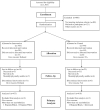Randomized trial of an intervention to improve mammography utilization among a triracial rural population of women
- PMID: 16954475
- PMCID: PMC4450352
- DOI: 10.1093/jnci/djj333
Randomized trial of an intervention to improve mammography utilization among a triracial rural population of women
Abstract
Introduction: Mammography is underused by certain groups of women, in particular poor and minority women. We developed a lay health advisor (LHA) intervention based on behavioral theories and tested whether it improved mammography attendance in Robeson County, NC, a rural, low-income, triracial (white, Native American, African American) population.
Methods: A total of 851 women who had not had a mammogram within the past year were randomly assigned to the LHA intervention (n = 433) or to a comparison arm (n = 418) during 1998-2002. Rates of mammography use after 12-14 months (as verified by medical record review) were compared using a chi-square test. Baseline and follow-up (at 12-14 months) surveys were used to obtain information on demographics, risk factors, and barriers, beliefs, and knowledge about mammography. Linear regression, Mantel-Haenszel statistics, and logistic regression were used to compare barriers, beliefs, and knowledge from baseline to follow-up and to identify baseline factors associated with mammography.
Results: At follow-up, 42.5% of the women in the LHA group and 27.3% of those in the comparison group had had a mammogram in the previous 12 months (relative risk = 1.56, 95% confidence interval [CI] = 1.29 to 1.87). Compared with those in the comparison group, women in the LHA group displayed statistically significantly better belief scores (difference = 0.46 points on a 0-10 scale, 95% CI = 0.15 to 0.77) and reduced barriers at follow-up (difference = -0.77 points, 95% CI = -1.02 to -0.53), after adjusting for baseline scores.
Conclusions: LHA interventions can improve mammography utilization. Future studies are needed to assess strategies to disseminate effective LHA interventions to underserved populations.
Figures


References
-
- American Cancer Society . Cancer facts and figures 2006. American Cancer Society; Atlanta (GA): 2005.
-
- National Cancer Institute . Report of the International Workshop on Screening for Breast Cancer. Author; Bethesda (MD): 1993. - PubMed
-
- U.S. Preventive Services Task Force Screening for breast cancer: recommendations and rationale. Ann Intern Med. 2002;137:344–6. - PubMed
Publication types
MeSH terms
Grants and funding
LinkOut - more resources
Full Text Sources
Other Literature Sources
Medical
Miscellaneous

